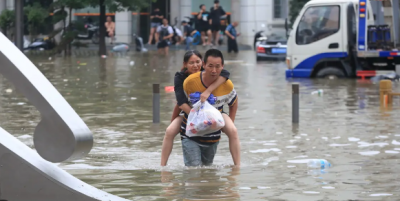Record amounts of rain have been falling for longer than usual in northern China, following the arrival of Typhoon Doksuri in late July. This has led to severe flooding and disrupted the lives of millions. After hitting the Chinese capital Beijing and neighboring cities in an area the size of Britain, the rains eventually moved to northeastern China near the borders with Russia and North Korea, remaining intense despite a decrease in strength. Doksuri is the worst typhoon the country has experienced in 140 years.
**How Intense is the Rainfall?**
The amount of rainfall since Saturday has broken numerous local records in Beijing and northern China, where the vast Heihe River basin has experienced the worst storm-related flooding since 1963. A reservoir in the Changping area of Beijing recorded 744.8 millimeters of rain between Saturday and Wednesday, the highest amount seen in the city in over 140 years. In the densely populated Hebei Province, one weather station recorded 1,003 millimeters of rain between Saturday and Monday, an amount usually seen over a year and a half.
**Why is it Raining Heavily for an Extended Period?**
Meteorological experts have said that as Doksuri's clouds moved north, the semi-tropical climate system and high atmospheric pressure were preventing accompanying rain clouds from passing through, leading to the continuous accumulation of water vapor. As large amounts of vapor condensed in northern China, low-level winds then carried it, causing the rains to shift eastward from the Taihang Mountain range where the most affected areas include Fangshan and Mentougou in Beijing. Meanwhile, Typhoon Khanun was gathering strength in the western Pacific. As it approached the Chinese coast, the weakening Doksuri became saturated with a large amount of moisture. Chinese meteorologists stated that the interaction between the two typhoons led to a sustained cycle with increasing rainfall amounts, resulting in extended and intensified storm impacts.
**What is the Extent of the Damage from the Rain?**
Floodwaters submerged hundreds of roads in urban areas of Beijing, causing hundreds of flight delays or cancellations. The impact was most apparent in the city's western suburbs. In the Mentougou and Fangshan districts, severe flooding washed away cars and cut off villages in mountainous areas, prompting authorities to deploy helicopters to drop food, water, and emergency supplies. In Hebei, floodwaters inundated half of Chuzhou City, which has over 600,000 residents southwest of Beijing, affecting about 134,000 inhabitants, and authorities evacuated one-sixth of the city's population.
**Have Similar Weather Phenomena Occurred in the Past?**
It is unusual for such heavy rainfall to persist for this long in northern and northeastern China following typhoons. Official media reported that the capital has witnessed only 12 instances of heavy rain caused by typhoons since record-keeping began. Typhoon Haitang and Ambly in 2017 and 2018 brought over 100 millimeters of rain to Beijing, while Typhoon Wanda in 1956 caused over 400 millimeters of rain to fall on the populous city. The impact of typhoons is also rare in northeastern China, with experts noting that most typhoons move westward or northwest after making landfall in China.




